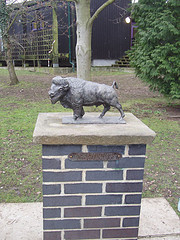Unknown Scout
| Unknown Scout | |
|---|---|

Silver Buffalo presented as a monument to the Unknown Scout
|
|
| Known for | a single "good turn" that inspired W. D. Boyce to bring scouting to America. |
The 'Unknown Scout' was an anonymous member of The Boy Scout Association in the United Kingdom whose good turn inspired William D. Boyce to form the Boy Scouts of America (BSA).
William Boyce was lost on a foggy street in London in 1909 when an unknown Scout came to his aid, guiding him to his destination. The boy then refused Boyce's tip, explaining that he was a Boy Scout and was merely doing his daily good turn. Soon thereafter, Boyce met with General Baden-Powell, who was Chief Scout at the time. Boyce returned to America, and, four months later, founded the Boy Scouts of America on February 8, 1910.
The story of the Unknown Scout has been described as "true, at least in essence." Some details, however, have been added to the known facts. According to Edward Rowan, Boyce stopped in London en route to a safari in British East Africa. While an unknown Scout helped him and refused a tip, this Scout only helped him cross a street to a hotel, did not take him to the Scout headquarters, and Boyce never met Baden-Powell. Upon Boyce's request, the Scout did give him the address of the Scout headquarters where Boyce later went on his own and picked up information about the group. Boyce returned to London after his safari and visited the Scout headquarters again and gained the use of Scouting For Boys in the development of a U.S. Scouting program. While Boyce's original account does not mention there being fog that fateful day, in a 1928 account he did say there was fog. Climatologists report no fog on that day in London.
James E. West, the first professional Chief Scout Executive of the BSA, contended with competing factions amongst the founders of the BSA, primarily Daniel Carter Beard and Ernest Thompson Seton, who pushed their pioneer heritage and American Indian themes respectively and personally ran their organizations. West usually just modified the British program and opted to push the story of Boyce and the unknown Scout. The origin of the fog into the legend came later, but there was no fog. By 1923 the fog was firmly established as part of the legend because in 1911 a man from Providence, Rhode Island was lost in a fog and helped by a Scout who refused a tip. This man was so impressed that he remembered Scouting in his will and West recognized the value of fog to the legend.
...
Wikipedia
